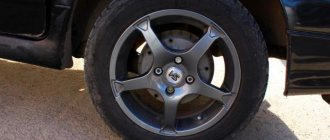Now it is difficult to establish whether the release of the Lada X-Ray in 2021 with a 1.8-liter engine was a previously planned move by the AvtoVAZ developers. Or the reason for this was their quick response to consumer requests, when immediately after the appearance of the first compact crossover model at the end of 2015, car enthusiasts expressed complaints about the five-door hatchback with a 1.6-liter engine.
In addition to the low engine power, there were complaints about the small diameter of the wheels, glitches of the robotic gearbox and the absence of a button to disable the towing control system, as well as the fact that the model has gasoline consumption disproportionate to the volume and power of the engine.
Therefore, the new crossover model has an engine of 122 horsepower, in contrast to the previous one of 106 horsepower. p., mechanical gearbox type, 17-inch wheels and has the ability to disable towing control. The basis of this car is the Renault Sandero, but the exterior design and interior are original, as is the suspension (it has been modernized), as well as the steering.
Related Posts
The reason why AvtoVAZ excludes the 1.8 engine from the Lada Vesta
Characteristics of Lada Vesta - what they hope for in 2021
In 2021, the high-clearance Lada X-Ray appeared with the addition of “Cross”, but a release with a Nissan engine of 1.6 liters and 114 hp appeared. With. temporarily stopped.
Specified fuel consumption of Lada X-Ray versions
For the user, it is not so much the passport, but the real fuel consumption x Rey that is important, but to understand why a car’s fuel consumption depends and to compare with real consumption, you should know the data from the technical documentation:
- Lada X-Ray (1.6 l., 106 hp.) - 7.5 liters per 100 km;
- intermediate Lada X-Ray with a Nissan engine (1.6 liters, 114 hp) – 6.9 liters;
- Lada X-Ray version (1.8 l., 122 hp.) - 7.1 liters per hundred km.
Based on the technical characteristics, we have the highest fuel consumption for the first version of the crossover, and the lowest for a car with a Nissan engine. These parameters were established as a result of laboratory studies and therefore cannot be considered a real operating standard, but serve only as comparative indicators. It is quite obvious that the actual fuel consumption data is higher than what the manufacturer indicates in the car’s passport.
Version with engine 1.6
The most affordable version of the Lada X Ray comes with a 1.6-liter VAZ-21129 engine, which has proven itself in previous models. It develops 106 horsepower, accelerating the car to 172 km/h, and to the first hundred in 11.7 seconds. Its gasoline consumption per 100 kilometers is:
- in the city 9.3 l;
- in mixed mode 7.2 l;
- on the highway 5.9 liters.
More expensive modifications are equipped with an engine with the same displacement of 1.6 from the partner corporation Renault-Nissan brand H4Mk with 114 horses with improved dynamics. It is known from other car models that are popular in the domestic market. One of its attractive features is reduced fuel consumption:
- in city mode 8.9 l;
- average consumption 6.8 l;
- on the highway 5.6 liters.
Reviews from Lada Xray owners
- Alexander, Orel. I took the simplest configuration in 2021, I can note that I am happy with my Lada X Ray, despite the criticism that fell on this car. The most important thing is that it is completely worth the money. Comfortable interior, suspension prepared for domestic realities. The engine cannot be stifled during break-in, but it is very reliable, although sometimes there is not enough traction, as for consumption, in general it turns out to be 10 liters per 100 kilometers.
- Valeria, Nizhny Novgorod. My husband bought a Lada Xray to get rid of my complaints about his SUV. I immediately liked the car; it handles equally well on the highway and on the country road when I go out to the country. The 1.6 engine with 106 horsepower pulls quite vigorously, it’s enough for me. The only drawback is that I want to change the manual to an automatic. On the free road, consumption is 7.1 liters, in urban mode up to 10-11 liters per 100 km, depending on workload and season.
- Sergey, Cheboksary. I bought Hray at the end of 2021, with a French 1.6 engine. I really liked this combination - it turned out to be a high-quality car, it in no way resembles VAZ’s previous creations. I like the sporty behavior on the highway and increased cross-country ability on bad roads, good handling. Consumption does not exceed 9 liters even in winter; on the highway you can easily keep it to 6 liters. This is somewhat lower than the technical data sheet, but I am happy with everything.
Gasoline consumption in real conditions
When driving a car, fuel is consumed inconsistently, and this variability depends not only on road and climatic conditions, but also to a large extent on the qualifications of the driver. If we take real indicators of possible fuel savings as 100 percent, then according to driver reviews:
- Fuel consumption is 60 percent dependent on the driver's driving style;
- by 15 percent of the air conditioner operating mode;
- 12 percent from driving with an insufficiently warmed up engine;
- by 5 percent when driving with the lights on;
- by 4 percent when driving with underinflated or wide tires;
- by 4 percent when the interior windows are open at speeds above 50 km/h.
From the above it is clear what the driver needs to pay attention to in order to use the fuel resource most efficiently and economically.
Engines
- HR16DE is a Nissan engine.
Reliable, with a mileage of up to 300 thousand km, it should not cause trouble to the owner. Can be sleeved. The timing chain drive will not require attention for several years. The throttle valve does not become overgrown with deposits and carbon deposits. It is equipped with high-quality phase shifter couplings. After 80,000, the valve thermal clearances will need to be adjusted.
- VAZ 21129 1.6 liters.
A reliable VAZ engine with inertial supercharging implemented in it, without the use of a compressor. It allows the engine to operate as efficiently as possible at low and high speeds. One of the disadvantages is the unsuccessful crankcase ventilation system. It works unevenly in traffic jams when power consumers are turned on, or when braking the engine. The cost of modernization is from 2500 to 3500 rubles.
- VAZ 21179 1.8 liters.
Converted VAZ engine with a volume of 1.6 liters. The oil channels have been improved and their number increased. An increase in engine volume was made possible by changing the piston stroke length and introducing a new crankshaft.
This threatens to reduce the resource of the power unit. According to reviews from owners of used Lada X-rays, there are failures during acceleration and high consumption of engine oil. VAZ engineers were unable to “defeat” oil burns; a factory recommendation was issued - 700 ml of oil per 10,000 km should be considered normal.
Car enthusiasts noticed this feature - in cold weather it works unstably and crashes. After a little warming up, this symptom goes away. According to AvtoVAZ employees, this is normal, it can be considered a feature of the internal combustion engine, there is nothing critical, it does not affect the service life
What is the real average fuel consumption of the Lada X-Ray?
Long-distance test drive data (mileage 500 km on Russian roads, both in the city and outside it). In the run-in mode, the Lada X-Ray hatchback with a 1.8-liter power plant showed:
- average consumption was 13.1 liters per hundred kilometers;
- outside city streets the average consumption was 7.5, and on city streets - 14 liters;
- the highest consumption on the highway was 9.1 liters;
- the lowest consumption on the highway was 6.5 liters;
- The minimum consumption in city-highway driving mode is 9.5 liters.
When driving after break-in, fuel consumption x rey may be lower, up to 10 percent of the test drive data.
Reasons for increased gasoline consumption
Having grouped the opinions of users and ranked the reasons for the increased consumption of combustible crossovers, they can be placed in descending order as follows:
- Due to the increase in engine warm-up time, heater operation and seat heating, consumption increases in winter.
- Due to frequent acceleration and braking.
- Due to the use of low-quality or low-octane fuel.
- When using electrical equipment.
- Due to malfunctions and incorrect adjustments of engine systems.
- For various other reasons such as the condition of the air cleaner, tire wear and type, as well as road and even weather conditions.
The actual fuel consumption of a car is very important for every driver, because expenses also depend on efficiency. Fuel consumption values are not constant and depend not only on operating conditions, but also on the skill of the driver. In this article, we decided to explain what the real average fuel consumption is for the Lada XRAY in various operating cycles.
According to the technical documentation, the fuel consumption of the Lada XRAY in the combined cycle (city/highway) ranges from 6.9 to 7.5 l/100 km:
- Engine VAZ-21129 (1.6 l, 106 hp) with manual transmission - 7.5 l/100 km;
- Engine VAZ-21179 (1.8 l, 122 hp) with AMT - 7.1 l/100 km;
- Engine Renault-Nissan H4Mk (1.6 l, 110 hp) with manual transmission - 6.9 l/100 km.
Based on the technical characteristics of the Lada Xray, the most economical option is the one with a manual Renault-Nissan engine. And the highest fuel consumption was observed in the 1.6-liter unit from AVTOVAZ.
The indicated vehicle fuel consumption in urban, mixed and extra-urban cycles was determined in laboratory conditions in accordance with UNECE Regulation No. 101R01. Serves for comparison of cars from different manufacturers and is not an operational standard.
Most often, in practice, fuel consumption turns out to be greater than what the manufacturer indicates, this is confirmed by the first reviews of XRAY owners :
- With a run of 500 km in urban mode, fuel consumption was 13.1 l/100 km;
- On the highway it eats tolerably, around 7.5, but in the city it’s 12 l/100km;
- Consumption on the highway showed - 9.3 l/100km;
- On the highway it shows 6.3 - 6.5 l/100km;
- Gasoline consumption on the highway is approximately 6.3 l/100 km;
- Consumption in the combined cycle (city-highway) is approximately 7.4 - 7.8 l/100km;
- Mixed consumption 9 - 9.5 l/100km.
All these reviews were written during the running-in period ; after 2000-3000 km, these values may decrease slightly.
Added to Fuel consumption //
Real reviews from owners about fuel consumption on the Lada X-Ray:
- For a long time I saved up for a new car, although there were no complaints about the old Honda, but still, we all dream of the best. My son advised me to pay attention to the new concept released by AvtoVAZ, namely the Lada X Ray. I immediately liked this car because it is placed on the Renault Sandero platform, thanks to which the car acquires such a characteristic as originality. The interior also pleased me with its decoration and quality. Naturally, the main thing in our time is not how the car looks externally, although this is an important detail, so we began to consider a more economical engine option. It turned out to be a 1.6-liter gasoline engine with 110 hp. Here we noted that when driving outside the city, a car consumes only five liters per hundred kilometers of road. Today this is very economical, since until this moment I had to fill my old Honda 2.0 with more than 10 liters of fuel per 100 km. Fuel consumption of the Lada X-Ray during the urban driving cycle reaches 9 liters of gasoline per hundred kilometers. After that, I fell in love with this car, because I immediately liked the look of it, but I didn’t think that it was possible to drive so economically.
- Nowadays, automobile production is booming, and despite the fact that electric cars are now in fashion, I still focused my attention on a concept such as the Lada X Ray. First of all, I liked the design of this car, the large and spacious trunk capable of holding 1570 liters. As you understand, I liked the crossover car. But the most important thing that pleased me was the fuel consumption per hundred. Since my work requires me to be on the road for quite a long time, and to be stuck in traffic jams even longer, the choice fell on the gasoline version, the volume of which is 1.8 liters 122 hp. It was interesting that with such a volume, a car outside the city consumes 6.5 liters per 100 km. When driving around the city, up to 10 liters of gasoline are consumed, and this figure is lower than that of the engine, whose volume is 1.6 liters. As you can see, this happens. For some reason I don’t like the diesel engine, since I’m used to gasoline. But as they say, there is no friend in color and taste. Now I’m driving and I’m not overjoyed, since on average, with a mixed cycle, driving takes 100 km. about 7.5 liters of gasoline. For this class of car this is more than enough.
- Of course, I’m not a racer, but when I bought the Lada X Ray, I looked at the “hot” representative of this concept for a long time. My car is equipped with a 1.6-liter gasoline engine 21129 (developed by AvtoVAZ Lada), the power of which is 106 horsepower. It immediately seemed to me that this was a gluttonous version of the car, but after I talked with a dealer who represents a line of Soviet cars, my opinion radically changed. He explained to me that the volume of a 2.7 liter diesel engine outside the city consumes the same as my 1.6 liter, that is, 6.5 liters of fuel are consumed per 100 kilometers. In my life I have driven many used cars, but now my brand new Lada X Ray crossover lifts my spirits to the skies.
We present to your attention information on the fuel consumption of the AvtoVAZ Lada Xray (XRAY) model. This car is a full-fledged compact crossover that went on sale in 2016.
The length of the crossover is 4164 mm, width 1764 mm, height 1570 mm. The wheelbase is 2592 mm. Trunk volume ranges from 324 to 770 liters with the rear seats folded.
Modifications are now available with a 1.6 liter engine with a power of 106 hp, as well as a 1.6 liter with a power of 110 hp, as well as a modification with a 1.8 liter engine with a power of 122 hp.
Transmission
On cars of previous releases, only a manual gearbox developed by the French was installed. It is reliable and lasts for more than 100,000 km. With timely maintenance and oil changes, the period increases by one and a half, two times.
The clutch disc linings were maintained for up to 160,000 km. For 1.8 liter engines, enlarged Valeo clutch discs were used, for 1.6 - LUK brand.











